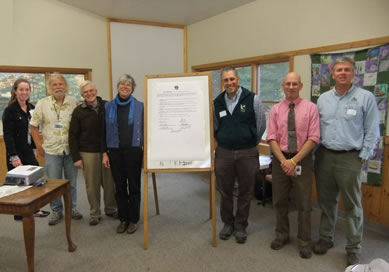Home → About → Founders' Story
ABOUT : Founders’ Story
This article appeared in the Spring 2011 issue of Savingland, a publication of the Land Trust Alliance.


If Aldo Leopold were alive today, he would certainly be celebrating the geographical reach of the land trust movement, as we hold high the banners he carried. Today's land trusts are advocates for a personal land ethic, for stewardship of the earth's finite natural resources, and for preservation of wild places in the midst of a civilized landscape. In my home state of Maine alone, 100 land trusts have a presence in communities from Kittery on the southern coast to Van Buren on the northern border. With our collective influence, we have the capacity to champion the ethical relationships that Leopold espoused. As we continue to conserve important lands, we should also be addressing a complex human ecology question in each of our geographies. Realizing that our influence goes far beyond the acres we conserve, what is the larger role of a land trust in its community?
Kennebec Land Trust (KLT) has focused on this question for the past two years. Our service region includes 21 towns and cities with 412,000 acres of forestland, lakes, streams and farmland. Natural resources support our local economies, agriculture, wood products markets, wildlife and recreational opportunities, all fundamental to our quality of life. Our communities are defined by conifer and hardwood forests and clear water-resources most consider permanent fixtures on the landscape. Against this setting, KLT's 3,850 acres of conservation land and 750 members represent 1% of our service area's population and land area. With the land and our mission in mind, we realized the importance of working with a broader set of conservation partners who share an interest in our region's forests and the resources and functions they support.
In 2009, inspired by work at the Harvard Forest, and with support from the Maine Forest Service, KLT organized a six-month forest stewardship program. A year later the Maine Forest Service and KLT launched a new conservation initiative, The Kennebec Woodland Partnership, which now includes five other lead organizations-Kennebec County Soil and Water Conservation District, Maine Forest Products Council, Forest Society of Maine, Small Woodland Owners Association of Maine and The Trust to Conserve Northeast Forestlands*. With a written set of common principles, we are bringing our individual tools and strategies together to address the long-term conservation of Kennebec County's forested landscape.
Creative partnerships like this one, which integrate ecological, economic and community dimensions, take time and require trust and open communication. Each partner has its own specific land conservation goals, but what we share is the forest commons. With a set of principles in place, we have created a foundation for our future work together. We realize that change takes time, and that public education is fundamental to our success. Our goal is to foster a culture of conservation that values our forests and their biodiversity, supports a sustainable resource-based economy, and promises a high quality of life. Perspective is critical. Quantifying land trust goals in acres, miles of trails, and membership numbers is informative, but these metrics do not fully measure the importance and potential of our work. Fifty years ahead, our communities' wellbeing and our landscapes will reflect today's ethics, conservation practices, and partnerships. We will have a better chance of a sustainable commons if we work together now.
*Since this article's publication, additional Partners now include the Sebasticook Regional Land Trust, the Maine CDC Drinking Water Program, and the Maine Department of Agriculture, Food and Rural Resources